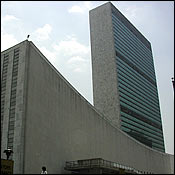Home > Arts & Events >
- PROFILE
- READER REVIEWS
United Nations
|
|
Official Website
Hours
Mon-Fri, 9:30am-4:45pm; Sat-Sun, 10am-4:30pm
Nearby Subway Stops
4, 5, 6, 7, S at Grand Central-42nd St.; 6 at 51st St.
Parking
- Nearby Parking Lots
- Street Parking
Profile
A concave row of flags representing the U.N.’s 192 member nations, from Afghanistan to Zimbabwe, spans much of this six-block-long international organization and independent territory. In October 1945, after two world wars and the failure of the League of Nations, 50 countries ratified the United Nations Charter, committing themselves to the lofty aims of international peace, security, cooperation and respect for human rights. Wondering how these goals are hashed out in the present? Set out on an hour-long tour of the headquarters, with one of the U.N.'s poised, uniformed, and multilingual guides. Visitors pass through select chambers, view special exhibitions, and hear an overview of how the U.N. system functions [see "tours" below]. Though unable to create laws, the U.N. has played an influential and often controversial role in international relations and debates over international law. Most infamous would be the Security Council, authorized to respond to security threats by issuing policy recommendations, economic sanctions, arms embargos or even collective military action. Other councils, programs and partner organizations include the General Assembly, the Economic and Social Council, the International Court of Justice (located in The Hague), the U.N. Children’s Fund and the World Health Organization (in Washington D.C.). Those waiting in line to enter the New York headquarters are greeted by a sculpture of a gun with the barrel knotted and a brass sphere reflecting the lawn and plaza. On one side of the U.N. lies the East River and on the other, delegate offices and a stairway leading up to Tudor City, a quiet, quaint enclave which diplomats and employees have been known to call home.
BookstoreA handy resource for U.N. reports and outside studies on international issues (women’s rights, environment, international trade, etc.) as well as language primers, dictionaries, and even travel guides. More typical items for sale include posters, stationery and CDs.
Post Office
Tiny and little trafficked, the post office owes its existence to the U.N.’s independent territory status. And while the idea of mailing a letter postmarked from the U.N. or of creating one’s own personalized postage stamp does have a certain hokey appeal, it’s mainly just hokey.
Guided Tour
Visitors view lavish gifts from member states—an intricate, carved ivory diorama from China, a giant Norman Rockwell-inspired mosaic from the U.S., the world’s largest tapestry from Belgium—as well as exhibits on decolonization, disarmament, and those blue-helmeted U.N. peacekeepers. Stops include the Economic and Social Council chamber and the Trusteeship Council chamber and conclude with the impressive General Assembly. Tours are offered in over 20 languages and have been completed by more than 37 million people since 1952. (Groups of 12 or more must call 212-963-4440 to reserve a tour in advance. $12.50, $8 seniors, $8 students, $6.50 children ages 5-14, children under 5 not allowed.)
Visitors’ Service
This inconspicuous, drab office supplies free copies of the U.N.’s Annual Report, press releases from various U.N. councils or meetings, and fact sheets on everything from how to become a tour guide to questions of diplomatic immunity to explanations of concepts such as female genital mutilation.

